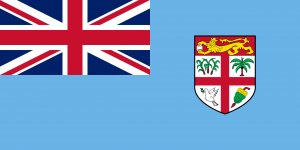Language/Fijian/Vocabulary/Fruits
Hi Fijian learners! 😊
In this lesson, we will learn about fruits in Fijian language, and some interesting facts about them. Fruits are delicious, healthy, and an essential part of our diet. Let's start exploring! 🍓🍌🍉
Take a moment to explore these relevant pages as you conclude this lesson: Food & Express Surprise.
Fruits[edit | edit source]
In Fijian, fruits are called "vua ni soli" or "vua ni kana". Fruits are an essential part of Fijian cuisine and are consumed in a variety of ways, including fresh, cooked, and dried. Fruits grow abundantly in Fiji, and the tropical climate provides ideal conditions for their cultivation.
Below is a list of some common fruits in Fijian language. Note that some fruits have different names depending on the dialect of Fijian spoken in a particular region.
| Fijian | Pronunciation | English |
|---|---|---|
| Vutu | vootoo | Pineapple |
| Gova | gova | Guava |
| Wabua | wambua | Watermelon |
| Tavola | tavola | Papaya |
| Kavika | kaveeka | Orange |
| Nanaso | nanaaso | Banana |
| Vai kana | vye kana | Grapes |
| Koronimoli | koronimolee | Lemon |
| Vi kana | vee kana | Cherry |
| Mbua | mbua | Mango |
| Ivi kana | eevi kana | Strawberry |
Interesting Facts[edit | edit source]
- Pineapples are not native to Fiji, but were introduced by Spanish traders in the late 1700s. - Guavas are versatile fruits, used both in sweet and savory dishes. The leaves of the guava tree can be boiled to make a medicinal tea. - Watermelons are a popular snack during the hot summer months in Fiji. They are a good source of hydration and essential nutrients such as vitamin C and potassium. - Papayas contain an enzyme called papain, which aids digestion and may have anti-inflammatory effects. - Oranges were introduced to Fiji by the British in the 19th century. They are high in vitamin C and make a refreshing juice. - Bananas are a staple food in Fiji and are eaten both cooked and uncooked. They are rich in potassium and carbohydrates. - Grapes are not commonly grown in Fiji, but are imported from other countries. They are a good source of antioxidants and may have health benefits such as reducing the risk of heart disease. - Lemons are used in a variety of ways in Fijian cuisine, from refreshing drinks to savory dishes. They are high in vitamin C and may aid in digestion. - Cherries are not commonly grown in Fiji, but are imported. They are a good source of fiber and antioxidants. - Mangoes are a beloved fruit in Fiji and are used in a variety of dishes, both sweet and savory. They are rich in vitamins A and C and may have health benefits such as improving digestion and reducing inflammation. - Strawberries are not native to Fiji, but are imported from other countries. They are a good source of vitamin C and antioxidants.
Dialogue[edit | edit source]
Here is a dialogue to help you practice using some of the fruit names in Fijian language:
- Person 1: E dina dali sai?
(Translation: Would you like a plate of pineapples?) - Person 2: Io, vinaka vakalevu!
(Translation: Yes, thank you very much!) - Person 1: Se kana i keke vutu oqo?
(Translation: Have you ever tried pineapple cake?) - Person 2: Sega, se dau kilai sara oqo.
(Translation: No, I've never heard of it.) - Person 1: Mo ni mai, keitou samaka vata ni keke vutu.
(Translation: Come over, let's make pineapple cake together.)
Conclusion[edit | edit source]
That's all for this lesson on Fijian Vocabulary - Fruits. We hope you enjoyed learning about the different fruits in Fijian language and some interesting facts about them. To improve your Fijian Vocabulary, you can also use the Polyglot Club website. Find native speakers and ask them any questions!
➡ If you have any questions, please ask them in the comments section below.
➡ Feel free to edit this wiki page if you think it can be improved. 😎
Sources[edit | edit source]
Finished this lesson? Check out these related lessons: Health & How to Say Hello and Greetings.
Other Lessons[edit | edit source]
- Days of the Week
- Food
- Drinks
- Geography
- Clothes
- Greetings
- Colors
- Feelings and Emotions
- How to Say Hello and Greetings

